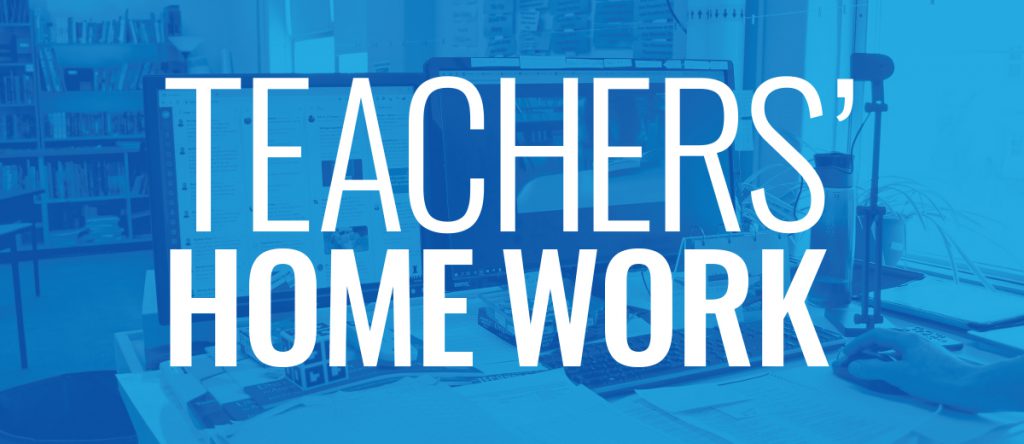
Manitoba public school teachers are having to solve a problem they’ve never faced: teaching students when none are in the same room. We are collecting and highlighting some here.
If you or your colleagues are solving the problem, let us know. Please email either Samantha Turenne or Lindsey Enns, we’d be honoured to tell your story.
Visits help lift spirits
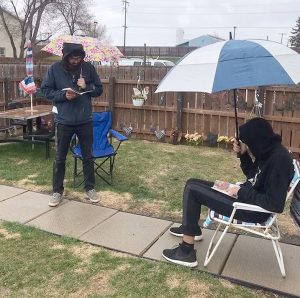 In rain or shine, Aaron Beckman has been visiting his students, from a safe distance, for the past several weeks.
In rain or shine, Aaron Beckman has been visiting his students, from a safe distance, for the past several weeks.
The Inclusion Support Classroom Teacher at Cecil Rhodes School brings his own chair, hand sanitizer and supplies when he visits each of his 12 students in Grades 7 to 9 at least once a week.
During his visits, Beckman, with help from an educational assistant, will take the time to catch up with his students before starting a mini lesson, which often includes reading a book and spelling practice. The visits last anywhere from 15 to 30 minutes and they’ve made a real difference in the lives of his students and their families, Beckman says.
“They’re excited, they think it’s really great that we’re there,” he said. “The parents really like it and I think they feel relieved that the onus is back on the teacher instead of them to lead the learning for that week.”
When he realized he wasn’t reaching all of his students via online learning, Beckman said he knew he needed to find a new approach. He said he was inspired by his family friend, Elaine Beauchemin, who teaches Grade 4 at Gabrielle-Roy Regional School and College in Ile des Chênes, to start visiting his students once or twice a week.
“When it was just electronic … I was getting maybe three or four out of my 12 students engaging in some way,” he said. “When I went to just paper and then the online conference it bumped up to maybe seven or eight, and now I’ve got engagement of around nine or 10.”
He says distance education has been a real challenge for his students and their parents.
“It’s a battle and it’s harder to get their kids to do this work than they thought and the online stuff is so complicated,” he said. “The foundation of everything that we do in the program is based on connection and based on that social connection and that sense of belonging.”
Being able to visit his students has also provided these families with some relief.
“It kind gives them a bit of a break,” he said, adding the students are often waiting for him to show up outside their homes. “The kids and the parents just light up when I show up.”
During a recent visit to one of his Grade 9 students, it started to rain, but that didn’t stop them from reading. Beckman said the student’s grandmother brought some umbrellas out for them to use so they could finish their lesson.
“I miss those kids too so to be able to see them and their families and just connect and just support them has been great.”
Where’s Ms. Moszynski?
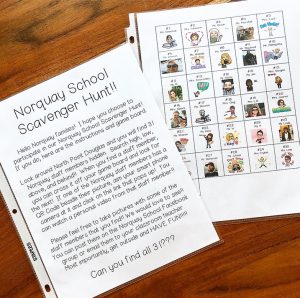 It has been more than two months since the suspension of in-class learning and for Teal Moszynski, a Grades 2 and 3 teacher at Norquay School, it has been difficult to stay connected with her students.
It has been more than two months since the suspension of in-class learning and for Teal Moszynski, a Grades 2 and 3 teacher at Norquay School, it has been difficult to stay connected with her students.
“Many of them don’t have access to technology which is why I’ve been trying to get creative with tasks I sent home,” she said. “I have tried to send things in their learning packages that let them know I’m thinking of them, and miss them dearly!”
Moszynski also knew she was not the only teacher struggling to maintain contact with students, so she put on her creative thinking hat and soon after the Norquay School Scavenger Hunt was born.
“I had inspiration from some of the outdoor scavenger hunts my nephews have been participating in, in their neighborhood,” she said. “I thought it would be a great activity to bring our Norquay community together.”
She knew that the scavenger hunt would work well in the community for the simple fact that it is something that all students would be able to access because it was right outside their front doors.
“I also wanted families to know that we are around for support even though we aren’t physically in the school building,” she said. “I also knew how much students were missing being at school, so I thought it could bring some comfort to them by seeing pictures and Bitmojis of all their favourite Norquay staff members.”
Moszynski began the scavenger hunt project by emailing all staff and asking for a Bitmoji or photograph from anyone who wanted to participate. Then, she created a poster for each participating staff member, which were hidden around the neighbourhood. The purpose of the scavenger hunt was to find the hidden posters.
Each student received instructions about how to participate as well as a playing board where they could see all 31 staff members that they are supposed to find.
“I also gave staff members the option to film a quick video saying hello to their students, which I created QR codes for and attached to their posters,” she said. “As soon as the posters were put up, I shared the news on our Norquay School Facebook group. We made this Facebook group in March and it has been one of the best ways to keep in contact with families.”
Within a few hours of sharing on Facebook, there were multiple families posting pictures of their finds.“Some said they’ve been searching for hours already,” she said. “I’ve had quite a few families message me saying that this has been their favorite family activity and how much fun they have been having outside.”
She said that parents have also been contacting her to ask about the whereabouts of specific posters – their child’s favourite staff members. Currently, the family in the lead found 27 of the 31 posters. The posters will be up until the end of June, so that families can continue their searches and hopefully find all 31 staff members.
Master chef challenge
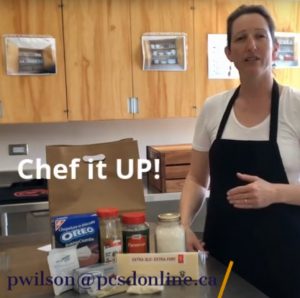 With “quarantine cooking” all the rage, foods and nutrition teacher, Penny Wilson decided there was no time like the present to launch a cooking challenge for students at MacGregor Collegiate.
With “quarantine cooking” all the rage, foods and nutrition teacher, Penny Wilson decided there was no time like the present to launch a cooking challenge for students at MacGregor Collegiate.
“The suspension of classes has forced our students into a unique opportunity,” she said. “They now have the capacity to dedicate more time to building on an excellent asset – food skills!”
For the month of May, Wilson is running a cooking competition for students in Grades 8 -12, based on the popular TV show Master Chef.
“It’s not a competition to be judged,” she said. “It’s a community pursuit for great food.”
Beginning on Friday, May 1, students will pick up “surprise boxes”, filled with ingredients and two recipe cards. Their task is to create the recipes and post the finished product on the school’s food and nutrition Instagram account.
“I’m offering a delicious diversion from our current abrasive restrictions,” Wilson said. “Food brings joy.”
The first surprise box contains ingredients like flour and parmesan garlic spice to Oreo crumbs and cream cheese. On the menu for week one is a first course of garlic cheese bread with an Oreo cheesecake for dessert.
While recipe cards are provided in the boxes, Wilson encourages students to be creative with their entries.
“If you want to run on the edge and make your own, I say, chef it up,” she said.
The top five contributors, judged by the number of posts to Instagram and photos emailed to Wilson will be crowned the Mustang Master Chefs and awarded personalized aprons.
Pandemic stacks caseloads of school social workers
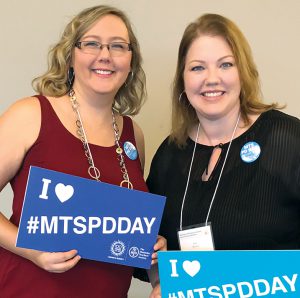 The COVID-19 lockdown has amped up stress levels in homes across the province. School social workers, the heroes of mental health delivery in Manitoba’s roughly 800 schools, see just how it affects children’s lives.
The COVID-19 lockdown has amped up stress levels in homes across the province. School social workers, the heroes of mental health delivery in Manitoba’s roughly 800 schools, see just how it affects children’s lives.
“Calls to kids’ crisis lines are up 350 per cent,” says Amber Zetaruk, president of the Manitoba Association of School Social Workers (MASSW) and Social Work Supervisor in the Louis Riel School Division.
Zetaruk and Kim Mackey, vice-president, head the two-year-old, 140-member special area group.
Like other school social workers, they would normally be travelling between schools to support students and teachers, but the pandemic hasn’t put the brakes on their work at all.
They’re in constant virtual contact with their schools and get dozens of emails daily. “We have online meetings with student services teams through Microsoft Teams. And all of us have a full schedule of students and families either through telephone counseling or video,” says Mackey.
“Occasionally we’re supporting kids and families who are not in a good place and not safe, so we help get them into shelters or safe houses,” says Zetaruk. “This has been exacerbated with so many people at home full- time.”
Mackey is fresh off the phone from consulting with a teacher about a learning plan for a struggling student.
Anxiety is higher for many of the children and families we help, she says. “Some are really affected by food shortages. Some by losing their connections to friends and adults. Others worry about whether they can succeed in this new form of virtual schooling.”
Indeed, the pandemic has made caseloads far more intense, says Jessica Askin, MASSW’s secretary who works in Garden Valley School Division.
Basic needs like getting food, staying safe and preserving mental health, even getting respite to exhausted parents, are at the forefront in a way they never were before. That’s the major difference between pre-pandemic and now, she says.
“There’s a scale and level of immediacy to the lockdown challenges that you just can’t ignore. It adds another layer of complexity to the lives of people already struggling and definitely increases our caseloads.”
But social workers are excellent connectors, she says. “If there’s no food bank in a community, social workers have formal and informal networks to lean on. They may call a youth pastor or Indigenous elders to help. There’s always a way to get things done,” says Askin.
Manitoba’s school social workers are members of MTS and their local associations. All have degrees in social work and are licensed members of the Manitoba College of Social Workers, which regulates the profession.
Zetaruk says while student services personnel work with students from one school, social workers serve the top five to 10 per cent of student cases in many schools.
Student services staff don’t need parental permission to work with a child, but school social workers do, except in cases where there is harm to others, the student threatens to harm themselves, or where the student is being harmed by someone else.
Social workers are taught to have professional boundaries and practice self-care. But Zetaruk and Mackey say it’s hard to not to let their work enter their personal lives.
“You always have a couple of clients you think about at night,” says Zetaruk. You ask, ‘What can I do differently, can I do more?’
Not every social worker wants to practice in an educational setting. Why choose to carve out a profession there?
“Everyone has their own story,” Zetaruk says. She had one meeting with a Social Worker when she was younger that changed her entire life. “One lady touched my world. It changed everything and I came away saying, ‘I want to do what she does.’”
Zetaruk says her personal experiences have been an asset to her in counselling students. Many of life’s experiences serve to inform social workers’ practice.
When opening a new case, social workers are on sacred ground, she says.
Whether it’s in person or over Skype, “You’re there to hear the student’s story,” she says. You want to hear what the student is looking for even if they don’t know where to start, even if you want to have them step out and take a risk. But you keep yourself in check and build that relationship first.”
Askin says many students don’t have wi-fi or computers and that’s a challenge to working virtually. “We can’t create a comfort level as quickly on a call, and it’s hard for us to read body language or even know if the call is completely confidential. There’s no way for me visually monitor self-harm either.”
Mackey started her career in Prairie Rose School Division and now works in Louis Riel School Division. She says whether working in the city or a rural division, it’s sometimes hard to get mental health service for students in the province right now.
Wait lists for services are quite long and the pandemic is making it worse, she says. “Everybody is doing the best they can – agencies, too.”
Zetaruk says breakthroughs with students, big or small, are golden moments.
“Sometimes we may know of a child who is dealing with something they’re not ready to tell us until they trust us. When they finally open up and we get the proper authorities connect to that child’s situation, we feel a sense of relief. We know the students will get the help they need.”
Until MASSW was organized two years ago, clinicians hadn’t been represented in the Society’s SAGE groups. Much of the training was teacher-focused. Officially organizing themselves was a big step.
Mackey says school social workers were scattered and isolated. “We didn’t know where everyone was or even how many of us there were.”
“Suddenly, to sit around the table with other clinicians and James Bedford, was wonderful,” says Zetaruk. “It gave us the chance to say, ‘Look we’re here too, we have a unique role and skills.’”
Looking back on the creation of MASSW, Mackey says there were two moving moments for her. “One was when we first put the word out that we’d be organizing and we watched the requests to join start to roll in. It was really humbling and exciting to see that.
“The other was at the first MTS PD Day we organized. When we had that first one. It was a real special moment to look around the room, feel that strength in numbers, and realize all of us were there to be together.
School social workers recommend these province-wide community support resources for students:
- Kids Help Phone: Text HELLO to 686868 or call 1-800-668-6868
- Anxiety Disorders Association of Manitoba Anxiety Support Line: 204-925-0040
- Klinic Community Health Crisis Line (24 hours): 204-786-8686 or 1-888-322-3019
- Manitoba Suicide Prevention and Support Line (24 hours): 1-877-435-7170
- Manitoba COVID Support Virtual Therapy for residents 16 years and over: https://manitoba.ca/covid19/bewell/index.html
Turn on the tube
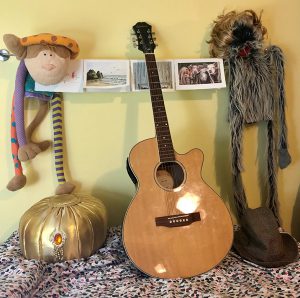 For Rich Palka, a multi-age Grades 1 and 2 teacher at General Byng School, thinking outside the box resulted in him teaching from inside the box – the TV box that is.
For Rich Palka, a multi-age Grades 1 and 2 teacher at General Byng School, thinking outside the box resulted in him teaching from inside the box – the TV box that is.
“I wanted to keep some semblance of our normal day and to keep kids engaged and comfortably challenged, and to make sure they are having a lot of fun,” he said. “I thought an interactive TV show was the best way to do this.”
Palka’s students are used to him teaching in character in the classroom, so he decided to bring these characters to the TV show. He also added some new characters for the TV show.
“Writers’ workshops are now being delivered by a strange wizard looking for wisdom in odd places, or a greedy newspaper editor hiring new reporters to write stories for his newspaper,” he said. “My daughters made cameo appearances as the fast-typing, news-hungry reporters.”
Math concepts are also included in the show, courtesy of “a very confident, but not overly impressive magician” who shares magical math strategies or a “desperate detective” trying to figure out secret number cases.
When creating the show’s characters, Palka said it was important to include the two classroom guinea pigs to help provide a sense of comfort and normalcy for the students.
“The guinea pigs are the funniest characters on our TV show. My wife and I do the voices,” he said. “The rule is if it makes us laugh then it should go on the show. We’ve been laughing into the wee hours recording these silly segments.”
The guinea pigs have become characters who talk and sing about their days away from the class and then set up academic challenges for the students. There are also frequent check-ins by two puppets the students are familiar with from their time in the classroom.
“I try to provide routine, a predictable pattern and stability by starting the day in the TV show in a way we normally would in class,” he said. “I use similar language and start by doing a yoga activity, just like always. We end the day with our end of the day song.”
Palka said that this is such an uncertain time, making it extremely important to recognize that there might be challenges that each family is facing, which he might not be aware of, but it still affects the student’s learning.
“I wanted to give my students and their families flexibility so that they can access the TV Show when it works for them,” he said. “I know some families are sharing devices, some have parents who are still working and many other challenges at this time.”
He said that some students choose to watch the show every weekday and even at the same time, while others take inspiration from Netflix and binge watch a couple of episodes in a row.
“I know this is such a big adjustment for all families and they are doing a great job,” he said. “I hope that my TV Show can bring some joy and silliness into their households while allowing them to do some rich learning along the way. I want to keep giving them the welcoming, engaging, safe, caring and fun place just like I always strive for. Yet, I also want to make sure not to overwhelm families at this time.”
Palka said he completely understands the challenges of balancing work responsibilities and families, especially at this time. He and his wife, also a teacher, have two children at home, ages six and nine.
“It has meant very long hours and sleep is definitely lacking, but we also look for the beauty in this unique and challenging situation,” he said. “It has led to a beautiful shared experience with my family making parts of this show together. From my daughters writing jokes to help inspire my students to send in their own jokes, to them helping develop characters and even composing theme songs for intros to some of the segments.”
He said that getting students to laugh is the first step in engaging them to learn.
“I hope the students and their families are having a good laugh every day,” he said.
Math matters
 The school closures have resulted in many teachers embracing online learning tools and platforms to stay connected with their students. These creative and innovative ways of teaching have been highlighted everywhere, and rightly so, but what is often left out of the story is the fact that many teachers have already been using these tools and the school closures have given them the opportunity to expand the use and further develop their repertoire of online resources.
The school closures have resulted in many teachers embracing online learning tools and platforms to stay connected with their students. These creative and innovative ways of teaching have been highlighted everywhere, and rightly so, but what is often left out of the story is the fact that many teachers have already been using these tools and the school closures have given them the opportunity to expand the use and further develop their repertoire of online resources.
“I’ve been uploading my lessons and notes for Grade 11 and Grade 12 pre-calculus to YouTube for the last year now,” said Matteo Di Muro, a math and computer science teacher at Vincent Massey High School in Brandon. “I wanted to share what I was doing to help close the gap of online learning for my students. I thought it may also be valuable for others as well, especially those who are teaching Grade 11 or Grade 12 pre-calculus math in Manitoba.”
Di Muro has started including quizzes and blank notes in the YouTube video descriptions so students can work and learn from anywhere with an internet connection.
“I’ve been listening to my students who wanted shorter videos, so I just started making 10 minute math reviews for my Grade 12 class,” he said. “These videos are focused on only one concept at a time in 10 minutes or less.”
He plans to continue making these short videos for a variety of math concepts for Grades 9 to 12.
He has also been supporting his teacher colleagues through a new podcast series called, 832 Sips: After Hours Education. During the segments, he and two colleagues from Saskatchewan, Dean Vendramin from Archbishop M. C. O’Neill CHS and Curtis Bourassa, an instructional technology consultant for South East Cornerstone Public SD chat about current issues facing educators across Canada, with a focus on the prairies.
“We highlight what teachers on the ground are thinking and doing that is useful and interesting,” he said.
Di Muro is an avid user of Wakelet, a free online content curation tool that brings together all the bits and pieces of online information about a particular topic and helps the user to organize and tell stories in the way that best suits their purposes. He has been using Wakelet to help create open educational resources with his students, instead of traditional tests.
“Each student made YouTube tutorials for a variety of topics,” he said. “Other students remixed my notes and created their own exercises, complete with solutions. The result is a Wakelet for Grade 11 computer science created by my students.”
Last semester his class was so successful in creating Wakelets that they were featured in the Wakelet Weekly Review, an e-newsletter sent out to thousands of users across the globe.
“It was a great demonstration of what learning can look like without tests, and what can happen when a group of students collaborate,” he said.
While, Di Muro is clearly no stranger to online learning and teaching tools, the switch to remote learning has not been without its challenges.
“Getting started is a big challenge. The lessons have to be specifically designed to be consumed online and then you have to actually create them. You have to get in the habit of always recording lessons,” he said. “Personally, my personal biggest challenge was getting over my fear of not being good enough.”
As he worked on setting up daily routines for his online lessons and content creation, he said that school helps to set routines for students and in the absence of this, it becomes that much more important to keep them engaged in learning.
“This is an incredibly trying time, mentally, and in so many other ways for students and their families,” he said. “We can each do our part to help sustain some sense of normal for everyone.”
He is also worried that because of the time spent out of the classroom, students will lose out on learning and struggle later on. This is his biggest motivation to continue sharing on YouTube and other platforms.
“Teachers have a very unique opportunity right now to really showcase their amazing work ethic and their incredible service to students,” he said. “Do something and share it with the world! Imagine all the people who might benefit from your act besides your own students. Let them share their learning with the world whenever possible.”
He said that if one person finds his material useful, then he considers it a success.
“This has also caused me to push myself further and has shown me that sharing my materials online is actually very relevant and a service that all teachers should consider as part of their professional mandate.”
Di Muro is happy to share his work and can be contacted at matteodimuro@gmail.com
Useful links
Grade 12 Pre-Calculus playlist
Grade 11 Pre-Calculus playlist
Food hampers to help feed hungry students
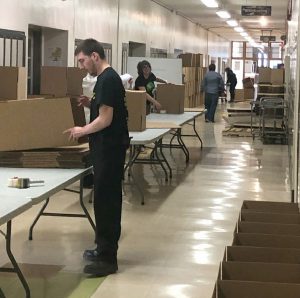 Thousands of food hampers are being prepared for the growing number of Winnipeg School Division students who depend on their school’s daily meal and snack programs.
Thousands of food hampers are being prepared for the growing number of Winnipeg School Division students who depend on their school’s daily meal and snack programs.
With school closures expected to last several more weeks, Karin Seiler, superintendent of inner city schools, asked principals to send her a list of students they thought could benefit from a food security initiative. Within one week, they had a list of approximately 3,204 students.
“So that means a lot of our families were missing the nutrition and the support that they were usually given on a daily basis through our meal programs,” Seiler said, adding she expects the need will only continue to grow over the coming weeks. “The longer jobs aren’t available and businesses are closed … families are feeling the pinch so we do see that need growing.”
Although they plan to officially launch the initiative on Monday, April 20, they have already had to deliver some emergency hampers. Hampers are being made available for pick up or will be delivered to the families on the list.
“I don’t know at this time what we can sustain … but we’re going to try and keep up,” Seiler said. “It all depends on the food available to us and the donations we receive.”
The Winnipeg School Division helps fund various food programs at their schools including breakfast programs, snack programs, emergency lunches, and milk subsidy programs as well as nutrition programs. Funds from those programs are currently being used to help purchase food for hampers.
The division is also gathering food and resources from partners such as Winnipeg Harvest, Peak of the Market and the Child Nutrition Council of Manitoba. Seiler says they are also ordering food through the distributors that normally supply items for their meal programs.
Food is being collected and then brought to either R.B. Russell Vocational School or Technical Vocational School, which are both equipped with a commercial kitchen and enough space to put the hampers together.
Seiler says the division is also collecting food and monetary donations during this time. Those interested in making a monetary donation can do so by contacting the Children’s Heritage Fund by calling 204-775-0231 or by contacting the Winnipeg School Division’s secretary treasurer office at 204-775-0231.
Food donations can be dropped off at either R.B. Russell or Tech Voc but they are requesting that you contact the school ahead of time to arrange a safe way to drop off donations.
Seiler says WSD staff are working hard to meet the needs of their students during this difficult time.
“The community is really stepping up and it’s really great to see.”
Other schools across the province are also pitching in to help provide food for their students.
Valley Gardens Middle School has started a nutrition program where their students and families can pick up food twice a week or have it delivered. Valley Gardens students are welcome to pick up food at the school while practicing safe social distancing.
“The other day it was ham dinners and sandwiches, along with dairy, desserts, and other staples,” read a post on the River East Transcona School Divison’s Facebook page. “The school has amazing partnerships with Giant Tiger and Superstore that provide ongoing support to the program and they are truly thankful for their generosity and for being charismatic partners within the school community.”
If your school or school division is doing something to help provide food for students amid the school closures, we’d love to hear about it. Feel free to contact either Lindsey Enns or Samantha Turenne.
The bell stopped ringing
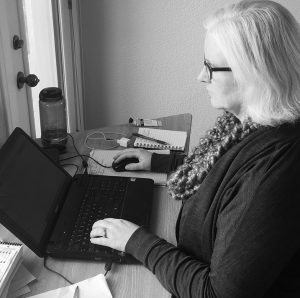 For the most part, since the school closures, teachers have turned to online tools to stay in touch with their students, immediately highlighting social inequities around access to technological devices and raising questions about internet connectivity in rural areas. However, the lack of access to iPads and internet is only one of the many challenges that teachers face as they strive to deliver education in the time of COVID-19.
For the most part, since the school closures, teachers have turned to online tools to stay in touch with their students, immediately highlighting social inequities around access to technological devices and raising questions about internet connectivity in rural areas. However, the lack of access to iPads and internet is only one of the many challenges that teachers face as they strive to deliver education in the time of COVID-19.
“When you have 87 students at once, it is a real challenge connecting with all of them,” said Laura McMaster, an English and Creative Writing teacher at Miles Macdonell Collegiate. “Some days it feels like a five minute mini-lesson has to be delivered to each kid differently, and at different times.”
McMaster also coordinates the school’s International Baccalaureate program, which means she has the additional responsibility of supporting teachers as well as “a ton of students who aren’t actually in my class.”
“I’m working in my laundry room which is hilarious. I was reminded to be careful about what’s on the drying rack behind me,” she said. “I work from 8-4 every day and have to remind myself to take a lunch break. No bell rings to tell me school is over and I should go home. Work is never over.”
McMaster said that some days are great, where she feels like she is making a difference and reaching her students, others not so great where she feels a real sense of loss.
“The dynamic of working together in the classroom is really hard to recreate online. Even video calls aren’t the same, and we’re finding that the more people use this technology, the worse its quality becomes,” she said. “I also miss my students like crazy. I wish I could go out and see them, even to deliver some books to support my reading program, but we’re told to stay home.”
She said that it is important to recognize the challenges that students are facing as well and has tried to reassure her students that feeling disappointed about the things they are missing out on is completely normal.
“Every championship game not played, solo not sung, grad dress not worn, ceremony cancelled, even the lunches in “our spot” with friends,” she said. “These are all losses that students feel deeply. It’s ok to be disappointed about these things even when some would say they’re unimportant in the grand scheme of things.”
She said that the sense of routine is really important for most of her students and she has been using Microsoft Teams to post daily activities at the same time she would have had they been in the classroom together.
“All my students have phones, even if they don’t have laptops, so I’ve heard from everyone at least a bit,” she said. “I learned pretty quick which students are sleeping until 2 p.m.! That makes it difficult for me to hit the work -life balance, which is so important, even more so when work feels like it never stops.”
She said that while the most important part of teaching will always be the relationships teachers create with their students, it is also important to model wellness and boundaries, especially at this time.
“Students message me at all hours of the day and night. I can’t do that, or I won’t be there for them tomorrow,” she said
McMaster has also established a routine for herself, “just to stay sane”. She starts the day by walking her dog, well before anyone else is up, followed by yoga at 4 p.m. and playing the piano after supper.
“I am having a lot of trouble sleeping. This is partly due to anxiety I think but also so much screen time,” she said. “I try to work with my sound off so I don’t get jumpy as I have so many students and staff messaging me through the day.”
She said that teachers have to first take care of themselves before they can do the best for the students, which can be another challenge when dealing with the far-reaching effects of COVID-19 such as spouses being laid off, concerns about finances and more.
“I’m lucky. I’m at a stage in life where I’m in a comfortable home, we have both our incomes, my kids can take care of themselves and are self-motivated learners and we each have our own laptops,” she said. “I know that not all my colleagues are in this boat. Some have little ones at home, a partner laid off, in the process of moving, ill parents – how to manage all this while also spending all day online support kids? I worry that this cannot be sustainable. How are we taking care of ourselves?”
She is also worried that the focus on “miracle teachers”, mostly driven by social media, creates even more challenges for teachers who are already struggling.
“This can be damaging for those who are just barely holding it together,” she said. “Hey, I think if you’re holding it together that’s a win! I said to a friend that I haven’t even cried this week, so that’s great! She replied, I haven’t cried yet today, so I’m making progress!”
McMaster believes that this experience will create some deep reflection on the nature and purpose of teaching.
“I’ve heard from parents who are so deeply appreciative of what teachers are doing, some who are just realizing what classroom learning has meant to their student,” she said. “I think in some ways we will learn to do less to do better, and to focus on authentic connections with students.”
She said that Joni Mitchell said it best for all of us, teachers, students, parents, “Don’t it always seem to go, that you don’t know what you’ve got till it’s gone?”
Reading recovery at home
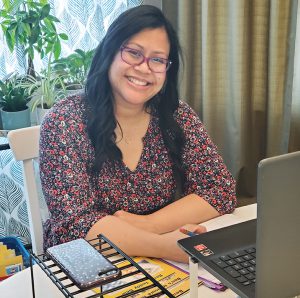 When it comes to reading recovery, face-to-face interaction is part of the program, which is why Melissa Carter knew she had to get creative during school closures.
When it comes to reading recovery, face-to-face interaction is part of the program, which is why Melissa Carter knew she had to get creative during school closures.
The reading recovery and literacy support teacher at Ecole Dugald School is used to seeing her small group of students for around 30 minutes daily during the school year. Reading recovery is an early intervention program for Grade 1 students designed to help reduce the number of children with literacy difficulties in schools.
“Reading recovery is a daily intervention,” Carter explains. “These are already struggling learners that have been chosen to be in this program due to their learning needs.”
In an effort to keep some normalcy in her student’s lives, Carter is continuing her 30-minute daily lessons with each of her students via video chat. She’s offered several options to her student’s families in terms of how they can stay connected during this time, but so far almost all of them have been finding the popular video app, Zoom, very helpful.
“Nothing really replaces being in person but to my surprise it’s been working wonderfully,” Carter said. “There’s only so much you can do over the phone. It would either be me reading to the students or them reading to me. I really wanted to do something that was face-to-face but I didn’t want to overwhelm families anymore than they already were.”
Carter begins her individual reading recovery lessons with a quick catch up, then she listens to her student read one or two books that they are already familiar with before moving onto magnetic letters. She asks her students to sort the letters to form words that they know and then into words they aren’t so familiar with. After that they move on to writing about a topic of their choosing, and if there’s enough time, she introduces a new book to them.
She says Zoom has been especially effective because it allows her to project books and magnetic letters onto the screen using her iPhone. For those seeking online reading resources, she recommends Unite for Literacy, which has books in a wide range of languages, as well as Epic! Books for Kids.
Although exploring online resources and learning how to use Zoom from scratch was originally out of her comfort zone, Carter admits it’s been beneficial in many ways. This time has also given her a chance to connect with her student’s parents more than she ever has before.
“We’ve both been able to see another side of one another, they get a peek into my life at home and I get a peek into theirs. I think in a way it strengthens our connection even though we’re apart.”
Keeping story time alive
 At the beginning of each school year, each classroom at École James Nisbet Community School is gifted a storybook from the administration. These books share the same theme – peace.
At the beginning of each school year, each classroom at École James Nisbet Community School is gifted a storybook from the administration. These books share the same theme – peace.
“This time has been a great opportunity to revisit and record some of our favourite peace books,” said Anthony Greco, a kindergarten teacher at École James Nisbet.
Greco arranged for 15 teachers to record themselves reading their favourite stories, and then he used the recordings to create a live program on Instagram called “James Nisbet Story Time.”
Now that Greco and his colleagues are working from home, he has invited them to continue to record videos so that he can keep adding new content to the program.
“Parents are commenting on posts and emailing how much their children are enjoying hearing their teachers’ voices,” he said. “This is providing students with a sense of comfort and joy and is an experience they can look forward to every day.”
He said feedback from parents including, “my daughter is so happy she heard the sound of your voice” and “my son requested to watch this again before going to sleep because he misses the whole class,” gives him the motivation to continue recording.
While the story time programing is new, Greco has been using Instagram as a way to stay connected with students and families since the beginning of the school year.
“I used Instagram to post fun activities, daily achievements, and school notes since the beginning of the year,” he said. “Families were on board with using it as a way to see what was happening in our classroom, so once we started learning from a distance, I figured it would be best to keep things as simple as possible so Instagram became my main vehicle for learning.”
Every day Greco emails his students’ families and posts an activity menu that parents can use as a guide. There are five activities in each post, which are reflective of what the students would be learning in the classroom.
“I do my best to get kids counting, communicating, writing, moving, and of course, playing,” he said. “Although, it may sound a bit strange given our current circumstance, I try to keep parts of our day as familiar as possible.”
He said not being physically present is an even greater challenge when it comes to the youngest students.
“The magic of kindergarten is learning together as a community. This is often experienced through building on authentic play-based learning driven by children’s curiosity,” he said. “I miss teaching an idea, singing a song, sharing a story and seeing the reaction on my students’ faces.”
Now that story time is part of the daily routine, students are able to participate in a read-aloud session with some of their favourite teachers.
“Viewing stories is a remarkable learning experience, which we love in our kindergarten classroom,” he said. “It is also an easy and effective way to quickly see who is viewing the content since the user profiles show up immediately after viewing the story.”
Greco’s wife, who is also a kindergarten teacher and is currently on maternity leave, has been using this experience to help teach and introduce some of her favourite math activities to Graco’s students.
Their nine-month old son has also made appearances in videos that teach good hygiene and handwashing practices.
“I encourage parents and guardians to share videos and pictures of their child’s learning so that I can create and post video montages of our learning experiences,” he said. “It’s important for students to see their friends engaged, happy, and going through similar experiences. This is our community.”
James Nisbet Story Time can be accessed on Instagram via “@instagartens.”
Mindfulness in a time of chaos
 In Robyn Eidse’s line of work, the focus is on building personal connections and sharing resources face to face with families and students. Then, COVID-19 happened and Eidse, an early year’s guidance counsellor at Kent Road School, had to quickly adapt and rethink her approach to ensure that students and families continued to receive the support they need.
In Robyn Eidse’s line of work, the focus is on building personal connections and sharing resources face to face with families and students. Then, COVID-19 happened and Eidse, an early year’s guidance counsellor at Kent Road School, had to quickly adapt and rethink her approach to ensure that students and families continued to receive the support they need.
“I need to preface with the fact that I came into this online teaching world with zero experience,” she said. “As a former classroom teacher, I dabbled into the world of Edmodo and Google Classroom, but only on a surface level.”
She said that it was especially important to stay in contact with students at this time, since a number of issues could arise as they try to understand and process the world around them, which can lead to an increase in stress and worry.
“Stress and worry does not always present the same in children as it does in for adults. In children it will often present in behaviours, dysregulation and big emotions,” she said. “Kids are also dealing with boredom because of the school closures. They are also practicing social distancing so they are not getting the same amount of social connections and physical activity that they are used to.”
Eidse decided that the easiest way to stay in touch with her 301 students and their families was by email and phone. With the staying in touch issue solved, she set her sights on looking for an effective way to continue to share resources.
“I decided to start a website, but I didn’t have a clue where to start,” she said. “I asked my teenagers for help and they just looked at me and told me that no one has websites anymore, so I began to research.”
After a few days of looking at other websites to determine what worked, what did not, what would be the best fit for her students, and their families, Eidse took the plunge and launched her own website.
“Many of my blog posts are ways to stay positive and keep busy during the school closures,” she said. “I have recently added a mindfulness component as well where I talk about the importance of mindful practice. Then I recorded some guided practices for students and their families.”
Her website has a comprehensive parent area that has resources specifically geared towards parents and includes free webinars supporting mental health learning. There is also a resource page filled with resources to support families, caregivers and students.
In just over two weeks, the site has seen more than 260 visits. It has been shared far and wide with other guidance counsellors, as well as with administrators at schools with no counsellors on staff.
Eidse is proud of the site’s success and is keen to keep adding more resources.
During spring break, she decided to add a self-narrated guided practice and a mindful section to the site.
“It is a passion of mine and I have seen significant benefits when guided practice is used in a school setting as a common practice,” she said. “I first had to learn how to do that, so I watched YouTube videos and set up a quiet room in my walk in closet. Then using my son’s PlayStation headset I recorded a guided mindful practice while recording my computer screen.”
She said that the experience was even more exciting and meaningful because it was something she was hoping to introduce at her school before the closures happened.
“I never thought that I would be able to navigate the blog or website world, but I did it and it has been a fun adventure,” she said. “The best part is that I am connecting to my families and keeping them up to date with resources during a really challenging time. It’s a way I can still help, even though I can’t see them.”
Homework in the North
 Teaching in remote Northern Manitoba can be a challenging task in its own right, but when you add a worldwide health pandemic to the mix, it presents an entirely new layer of stress.
Teaching in remote Northern Manitoba can be a challenging task in its own right, but when you add a worldwide health pandemic to the mix, it presents an entirely new layer of stress.
“It’s a stressful time,” said Goldie Hennebury, a teaching principal at Stevenson Island School, whichpart of the Frontier School Division. “We’d love to be able to get up in the morning and see our kids but we can’t do that right now.”
With their school being closed and access to internet unreliable, they’ve been creating homework packages for their nearly 20 students. Goldie is one of two teachers at the small school on Stevenson Island that has been delivering these packages to students over the last few weeks.
Since their students and families live on neighbouring islands to the school, Goldie travels along the ice road to hand deliver the homework packages. Once the ice melts, she’ll have to travel by hovercraft or boat to get her students school supplies.
“We just give them everything they would need,” she said. “It’s so they have something to do but they’re still staying engaged in learning.”
Since they can’t rely on online classrooms or resources, they’ve had to get creative with their homework packages. Goldie fills a sanitized Rubbermaid container with things such as books, pens, paper, art materials, craft kits, math games and games for students to play with their family members. She delivered packages to her students before spring break and plans to make another delivery this week.
They are also looking at lending out some iPads to students in coming weeks as well as delivering food hampers to their families.
“We’re not teaching anything new, we’re doing review, we’re doing reading … and just trying to keep going.”
Goldie says her students and their families are used to this since as the weather changes, not every student can always make it to school during the school year.
When it comes to teaching in a remote community, she says access to the internet and the location of their students are among some of the biggest challenges they face. Despite all of this, they are learning new ways to teach their students to the best of their ability while managing being in isolation during this difficult time.
“We are coping and we know all of the families well so that gives us an advantage,” she added. “The main thing is that we’re doing the best we can for everybody.”
History and geography at home
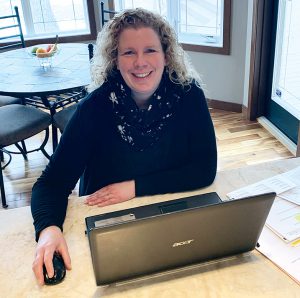 Elana Spence has been searching far and wide for ways to keep her high school students engaged in learning about history and geography while at home.
Elana Spence has been searching far and wide for ways to keep her high school students engaged in learning about history and geography while at home.
Spence, who teaches Grade 10 geography and Grade 11 history at École Edward Schreyer School in Beausejour, says one of the online resources she’s found useful so far is Socrative. The classroom app guides students through a series of questions, which include multiple choice, true or false as well as open ended questions, and then provides additional information about the subject.
“I can also watch the kids as they’re working through it … and that way I can highlight some trouble spots if needed,” she added. “I wanted to spice it up a bit because without that classroom interaction it can get a little bit boring.”
She’s also been learning more about integrating Kahoot, Quizlet and Breakout EDU, which is similar to a digital escape room for students.
“I want to keep it interesting and keep the students engaged,” she said. “These kids are more isolated than they’re used to being.”
With that in mind, she’s hoping using Geocaching as part of her geography class will encourage her students to spend some time outdoors. The outdoor scavenger hunt game using GPS leads participants to a specific set of GPS coordinates as they attempt to find a geocache (container) hidden at that location. Spence has also shown her students how to use Seek by iNaturalist, which uses image recognition technology to identify any plants and animals you find outside.
“That’s a really good one and kids from Kindergarten to Grade 12 can use it.”
In the coming weeks she plans to start giving her students some choice project ideas to work on. These would include creating a family tree, watching a movie and documentary on a historic topic and writing a review, as well as interviewing a grandparent by phone or via FaceTime about what it was like to be a teenager when they were young and compare it to their own life story.
“This is an opportunity to make a connection with a family member that they maybe haven’t before,” she said.
The most magnificent thing
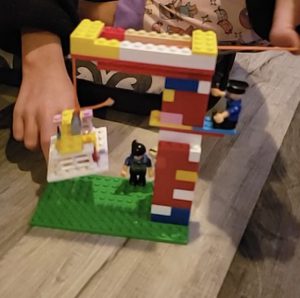 Christi Benoît, a multi-age grades 1 and 2 teacher, has made staying connected with her learners and their families her number one priority during the school closures.
Christi Benoît, a multi-age grades 1 and 2 teacher, has made staying connected with her learners and their families her number one priority during the school closures.
“I am currently connecting with my students on a daily basis VIA SeeSaw” she said. “The app allows me, as well as the students’ specialist teachers from phys-ed, music and even guidance to post daily learning invitations and activities.”
Recognizing the importance of mental health and overall well-being in these uncertain times, Benoît has made a point of calling her students and their families every Monday to do a wellness check-in.
“During these phone calls, I ask how their day is going, anything on their mind, things like that,” she said. “It is a great way to still share those special moments and continue to build and maintain those relationships.”
Benoît acknowledges that teachers and students are dealing with an entire new way of teaching and learning which makes flexibility an important component when planning for the next months.
“My goal for home learning is to try and keep learning as meaningful as possible. In my classroom, I do a lot of STEAM, so I wanted to keep that alive as possible,” she said. “I want to foster a Thinking Classroom where learners have daily opportunity to be thinkers, mistake makers, risk takers, and explorers.”
With the classroom element removed, Benoît is committed to showing her students that learning, creating and thinking can and will still occur beyond the barriers of the walls of the classroom.
In preparation for learning at home, she assembled take-home activity bags for each student, filled with school supplies, paper, STEAM based & creative learning invitations, practice work books that the students were already are familiar with, as well as creative tools such as Play-Doh, scissors, and arts and crafts supplies. The supplies came in handy for the students’ first at-home assignment.
“I posted a read-aloud of myself reading The Most Magnificent Thing, a book by Ashley Spires,” she said. “After reading the story, I Invited my learners to engage in the STEAM process by encouraging them to design and create their own most magnificent thing!”
The criteria for creating “the most magnificent thing” was actually quite simple. Students could use any household item, arts and craft supplies, Lego, or even Play-Doh to design a plan and create their masterpiece. Then, they recorded themselves explaining what they created and why it was magnificent.
“This activity was great because it had the kids creating, communicating their thinking, and many collaborated with a sibling,” said Benoît.
Although the school closures were unexpected, Benoît said it has taught her a lot about the importance of her role as an educator in the lives of her students. And, while she is no longer standing in front of a classroom teaching her students, she is confident that the relationships formed in classrooms are in no way tarnished.
She said she could still hear the excitement in their voices when they add a post on SeeSaw and see the smiles on their faces when they upload a post showing her something that they have created. She can still hear the emotion and trust in their voices when they share a phone conversation and talk about how much they miss their friends at school.
“If we can all learn one thing through this process, it is to never take what we do in our classrooms, and the relationships that we build with our students, for granted,” she said. “This experience has taught me that learning together is something so much bigger than anything that could ever be confined to the walls of a classroom.”
For their next project, Benoît’s students will be creating their own schools using boxes, maps of their school, pictures, labels and of course their imaginations.
Can Geo Education launches online classroom
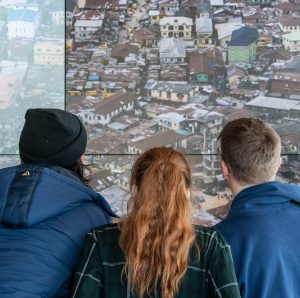 Students can virtually explore the world or learn about backyard biodiversity and climate change thanks lesson plans and resources on Canadian Geographic Education’s first Online Classroom.
Students can virtually explore the world or learn about backyard biodiversity and climate change thanks lesson plans and resources on Canadian Geographic Education’s first Online Classroom.
“Our existing website is a great place to find resources, but we have always dreamed of having a more interactive online platform that sees topical resources released at regular intervals to teachers,” said Michelle Chaput, acting manager of education programs at Canadian Geographic Education. “Our Online Classroom now gives us the chance to do this, and also to reach a wider audience that includes not only teachers, but parents and youth too.”
The classroom, which was launched on March 31 and can be found here: https://onlineclassroom.cangeoeducation.ca/, includes lesson plans and teaching resources for students in kindergarten to Grade 12. Parents, teachers and students are invited to register to receive a monthly newsletter with tips on all things geography, including maps and posters, as well as the ability to apply for grants and awards.
The classroom’s inaugural resource was their Anthropocene Education Program, which is a collection of virtual reality, photography and film that explores the human-environment relationship and gravity of human impacts on the earth. The program includes a collection of audiovisual resources that takes students out of their classroom or home into unfamiliar environments around the world.
“Geared toward Grades 4 to 12, this initiative develops student’s understandings of our world’s most pressing environmental challenges, such as plastic waste issues, species extinction and climate change,” Chaput said. “Through evocative photography, a documentary, 360-degree cinematography, and captivating augmented-reality installations, this multimedia project explains the emergence of the Anthropocene epoch, distinguished by human-caused changes to our planet.”
Each week new activities and resources will be added exploring themes such as Anthropocene, relationships of populations in Canada’s history, energy literacy and sustainable development as well as current events, including COVID-19. All of the resources, which are written by educators, include links, short activities as well as more formal or traditional lesson plans with reliable sources that dive deeper into the subject matter. They will also be incorporating Indigenous education materials on their Google Voyager story on Indigenous Cultural Heritage as well as their Indigenous Peoples Atlas of Canada project, which will be uploaded soon.
“Teachers can look at a specific age group for resources, but we encourage them to visit the other age groups as well as many of our activities can be modified to suit higher or lower grades,” Chaput said, adding everything they offer is also bilingual. “We have put out a call to any teachers or educational assistants interested in volunteering their time with our organization. So many teachers are doing wonderful things and so many teachers love to share what they do. We would like to feature some of their work on the Online Classroom.”
When it comes to keeping students engaged in remote learning, Chaput says regular video check-ins can go a long way.
“Even if the entire class cannot make it on the call, those who can will truly appreciate seeing a friendly face,” she said. “Keep activities short and to the point, but with an element of fun or whimsy to capture their attention.”
Despite being a geographical organization, Chaput says teachers covering all kinds of topics could benefit from their Online Classroom.
“Geography is at the heart of everything, of every subject and every research question, there is going to be something for everyone.”
Peg City teachers take learning to IG
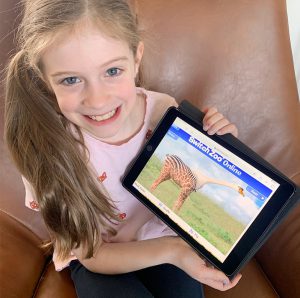 It started out as a way to keep teachers connected through the class suspensions, but in one week, the @pegcityteachers Instagram account has amassed a following of 250 users and more than 1,000 profile views.
It started out as a way to keep teachers connected through the class suspensions, but in one week, the @pegcityteachers Instagram account has amassed a following of 250 users and more than 1,000 profile views.
The account started by Jennifer Scott and Colleen Heuchert-Hammell, Early Years Support Teachers with the Winnipeg School Division, is now being used by teachers and parents to help with remote learning.
“We were looking for an effective and efficient way to provide continued support to our teachers virtually,” said Scott. “But then our friends, who are parents, started to come to us looking for advice on how to set routines and homeschool their children during the school closure.”
Scott and Heuchert-Hammell are both experienced in teaching many grade levels and were former Special Education Resource Teachers.
Through @pegcityteachers, parents and teachers, were invited to participate in a 20-day learn at home challenge, geared towards students in kindergarten to Grade 8.
Each day, the challenge is an engaging project-based learning theme tied to the Manitoba curriculum and the 4 Cs of 21st Century learning – communication, collaboration, critical thinking, and creativity.
Some of the challenges have included things like learning about angles and then using that knowledge to build a fort to use as a reading nook to having students create their own animals on the Switchzoo website and watch Assiniboine Zoo’s livestream Creature Feature.
Mental health and well-being is also on the agenda, with the first challenge asking students to use a Kal Barteski art piece to help them reflect on how they will spend their spare time, while staying in and practicing social distancing.
“It has been such an exciting and rewarding experience for both of us,” said Heuchert-Hammell. “We’ve seen consistent engagement from both teachers and parents which tells us how needed a resource like this really is.”
One of the biggest challenges for the duo has been choosing from the numerous virtual learning platforms, which have seemingly tripled since the COVID-19 pandemic forced worldwide school closures.
“Both professionally as teachers, and personally as moms, we’ve noticed that while effective virtual online learning is possible, it’s a unique challenge when we’re bombarded with a variety of ways to connect virtually,” said Scott. “Staying connected with students is critical right now but equally important is finding an effective online platform which allows for meaningful contact, connection, and interactive learning.”
Scott acknowledges that while a more all-encompassing tool like Google Classroom or SeeSaw could provide additional components to simulate those of the classroom the choice to use Instagram was simply because both teachers and parents already use it
Louise Waldman is one of the parents who has been using the challenges on @pegcityteachers to keep her daughter engaged and learning over the school closure.
“My daughter told me that she’d never before started spring break wishing she could be in school,” said Waldman. “Checking in with Peg City Teachers on Insta every day has been a great way to add some routine and normalcy to our ways. And a way for her to feel connected.”
While Scott and Heuchert-Hammell are isolated in their own homes, they both agree that this has been a positive experience and that their collaborative efforts have strengthened their resolve.
“Instead of focusing on germs and COVID-19 our attention is on connecting with others, giving back to our community, and highlighting other local Winnipeg individuals and businesses like The Assiniboine Zoo, Kal Barteski, and Siloam Mission,” said Heuchert-Hammell. “Interactions with a community of followers who have a shared purpose to create meaningful learning experiences for our students is heart-warming.”
Teachers ‘doing a remarkable job’
 Manitoba’s education minister and premier are commending the efforts teachers are making to keep their students engaged in distance learning amid the COVID-19 pandemic.
Manitoba’s education minister and premier are commending the efforts teachers are making to keep their students engaged in distance learning amid the COVID-19 pandemic.
“Teachers have been doing a remarkable job,” Education Minister Kelvin Goertzen said following Tuesday’s announcement that Manitoba is suspending K-12 classroom learning indefinitely for this school year. “Our teachers and the staff within our school system, they have taken on the challenge of ensuring that students continue to learn and progress and they’ve done it with professionalism and passion and we are tremendously proud of them.”
Premier Brian Pallister echoed that same sentiment and spoke about the importance of a quality education in Manitoba.
“Resiliency matters, education matters, both are essential to us bouncing back as we will from this pandemic’s challenges,” Pallister said. “Quality education will be vital in our economic recovery long after this pandemic passes.”
No students will be held back because of COVID-19, but students must actively engage in learning, Goertzen added. ,
“While this continued learning will be difficult for younger students particularly, we are actively working with school divisions to find best practices and enhance their existing resources,” he added. “I join all Manitobans in asking educators to continue doing all they can to use remote and innovative methods to teach students through the remainder of this school year.
“Our government is asking for an all-hands-on-deck approach, with their assistance and with that of parents, caregivers, principals, trustees and superintendents for the benefit of all students.”
Epic teacher lip dub
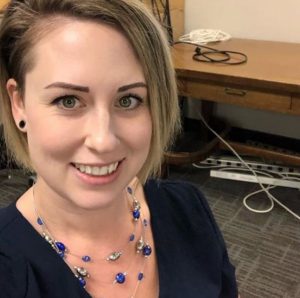 Ready for some much-needed spring break cheer? This seriously fun lip-dub from the teachers and staff of Mountain View School Division absolutely delivers.
Ready for some much-needed spring break cheer? This seriously fun lip-dub from the teachers and staff of Mountain View School Division absolutely delivers.
Staff from 15 area schools and buildings put this video together to bring joy to their community. The side benefit was an invaluable opportunity to hone their technology chops as they move to more ed tech options for their students. Teachers, principals, EAs, coordinators, computer technicians and so many others choreographed, performed and shot video.
MTS member Kirsten Thompson, ICT co-ordinator for the division, pulled all the magical clips together into the final production. “Our staff participation really doesn’t surprise me. MVSD has a great sense of community and we’re always looking for new ways to strengthen our understanding to benefit our students.”
Staying connected without technology
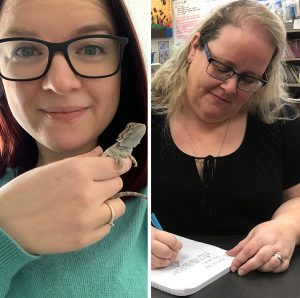 Writing letters, phone calls and delivering homework packages are just some of the ways teachers at Juniper Elementary School in Thompson are staying in touch with their students.
Writing letters, phone calls and delivering homework packages are just some of the ways teachers at Juniper Elementary School in Thompson are staying in touch with their students.
“It’s more of a community here than it is a school and it’s like a sense of loss,” Grade 4 teacher Kelley Taite said, referring to class suspensions across Manitoba. “Our schools are so sad, teachers are sad, we’re used to having little people with us.”
Taite said it’s important for teachers to let their students know now more than ever that they’re here for them.
“I think the kids still need to see that we’re still here … and we’re still working towards their education.”
With that in mind, Taite and other teachers at the school have been finding all kinds of ways to teach their students lessons outside of the classroom. Since not every student has access to technology, they’ve had to be creative. Hand written notes, phone calls and making homework packages has been a school effort over the past several days.
“In times like this when we go out of our comfort zones, we can provide a quality education,” she said. “Just having that communication piece, being able to write, telling them what we miss about them, just having that old fashioned piece has been great.”
While some teachers plan to pull out their tape recorders to send their students messages that way, others are creating videos.
Kaidie Morris, who teaches Grades 1 and 2, has been sending her students a video of her reading every morning, just like they would start their days normally in class. She’s also been sending them video updates of their class pet, Bruni, the bearded dragon. Since some of her students don’t always have access to technology, Morris says the videos are great because they can watch them on their own time.
“Everyone’s experiencing new challenges but up here we have a lot of kids without technology,” Morris said. “But we do have the advantage that we’re a small community so we can deliver work to them easily if needed.”
Taite says she’s hoping to keep the school’s land based lessons alive by making videos about ice fishing and how to make a dream catcher.
“We’re really looking at doing everything we can to reach our kids,” she said. “I’m quite excited about what our Manitoba teachers have done, and I’m proud to be one of them.”
Musique de la kitchen
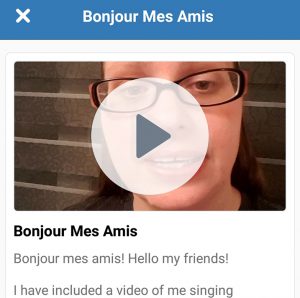 For those of you not familiar with Franglais, the unofficial – official language of Canada, musique de la kitchen means music from the kitchen. The kitchen is where Jennifer Paszkat has moved her music class.
For those of you not familiar with Franglais, the unofficial – official language of Canada, musique de la kitchen means music from the kitchen. The kitchen is where Jennifer Paszkat has moved her music class.
Paszat, a dual track teacher (French/English) quickly realized that the class suspension meant that some of her students would not have access to instruments at home, so she did the next best thing- she started a kitchen band.
“My Grade 2 students had the opportunity to go to the WSO for a concert and we heard the musicians creating music using things found at home, so I figured why not and the kitchen band was born,” said Paszkat, a K-2 music teacher. “I want them to practice some rhythmic patterns that I have provided. They can compose music or just have fun doing the rhythmic patterns.”
The intent is that the students progress from making the instruments to doing the rhythms eventually moving on to composing.
In addition to music, Paszkat also teaches Grades 1 and 2 Early Exposure French another subject that is extremely hands on with a predominately oral based curriculum.
“For many parents their only prior experience with French was when they went to elementary school,” she said. “We also have a large number of EAL students, which means their parents, are learning English and may not have the confidence to help their child in French.”
She turned to SeeSaw, a program recommended by her school division for communicating with families, and ended up creating videos that fulfilled the needs of all her students – la musique en français.
“I know all my Grade 1 and 2 French students know our welcome song Bonjour mes amis so I asked them to make a video with their family,” she said. “It was a beautiful example of how students can teach their parents and it was obvious how much fun everyone had. We had whole families singing together, moms and their kids. This is what it should be like.”
Paszkat said her favourite video was the student who had her cat on her lap, while mom was singing in the background.
“It has been great to see the couple of students who are reluctant participants in French singing away,” she said.
She has also been in contact with a musician friend who is also a French teacher and convinced him to put on a live concert in French for her students.
“We have done some of his songs in French class, so the kids were familiar and eager to participate. There is that cross-curricular connection again – French and music.”
Paszkat is very grateful for all the work parents have been putting in and sings their praises. She also offers reassurance in a time of great upheaval.
“As a parent this can be overwhelming. You have to work from home, if you are still working, you have kids of various ages and abilities and you might have older family members in your household you care for,” she said. “Parents do not need to run a school in their house. Do not feel bad if your kids played on the iPad or watched TV more then they did math. Do not feel guilty. What kids learn is amazing. They remember things we forget and that in itself tells us they are learning.”
She said it is important to not burden parents with busy work and while she posts links of resources and activities she considers helpful or interesting, it is only a suggestion for those parents looking for something extra.
“I trust our families are doing what works for them,” she said.
Paszkat, the mother of two boys, one in kindergarten and the other in Grade 3, uses them to trial the activities she plans for her students.
“If I get a thumbs up from them then I know it is worth posting,” she said.
While she is working hard to keep students engaged, she is painfully aware that there are some who are not logging in.
“It is always a worry when you don’t see or hear them because they are like your extended family. You get to know and care for them. You get to know their families,” she said. “There is a special place in my heart for all my students. I want to know they are ok and vice versa.”
A secure foundation for learning
 Randal Bychuk appreciates order in a classroom, along with a good dance-off. Throughout his almost two decades in education the elementary years teacher has created spaces that are at once structured and purposeful, imaginative and warm. That framework creates a secure foundation for learning that his students rely on.
Randal Bychuk appreciates order in a classroom, along with a good dance-off. Throughout his almost two decades in education the elementary years teacher has created spaces that are at once structured and purposeful, imaginative and warm. That framework creates a secure foundation for learning that his students rely on.
No surprise then, that in the unprecedented circumstances in which we find ourselves, Bychuk sought to recreate that same sense of security in his now virtual Grade 4 classroom.“This all happened fast,” says Bychuk of the planning he and his École South Point School cohort of four Grade 4 teachers began less than two weeks ago. “We wanted to create a sense of continuity so that an already overwhelming situation wasn’t made worse. So our team worked out a plan for the first five days of suspended classes that supported learning in a way that would ease all of us—teachers, students and parents—into what could be a longer term situation.”
The result was a schedule that mirrored a regular school day, with flexibility built in to accommodate down time.
“We wanted to put structure to the day yet we understood that these were not regular school days. There needed to be a balance between the need to stay connected with school with the need to decompress. And we didn’t want to overload families who may have more than one child in school, and so more than one schedule to manage.”
His students’ days are divided into subject areas, and hours are allocated to the study of numeracy and literacy, along with a well-being hour so students can switch gears and get active, and a creative time for exploration of art and emotion. In addition, Bychuk assigned a STEM project, building a periscope, which permits cross-pollination of themes related to science, art and design.
Like many of his colleagues, Bychuk has turned to technology to facilitate learning and interaction between him and his students. A program called Flipgrid has been a game-changer.
“With Flipgrid I can do some really creative things. I post a 30-second video question every day at 9 a.m., so the students know it’s a routine. They expect it every day. They see the question, which could be anything, something like ‘what did you do on the weekend’ and create their own 30-second video in response to the question. I get to react to the video they share, but the great thing is the kids get to comment on each other’s work as well. It’s fun and it keeps the kids interacting the way they would if they were in school together.”
That’s week one of class in a COVID world. So, what happens next?
“For the first five days, because we’re all getting used to a very different way to work and learn, my group focused on introducing the technology and getting into a routine; there was lots of review in the work assigned. Now we’ll move towards a more curricular approach so we’re staying on top of what needs to be covered.”
As for technology in his toolkit, Bychuk isn’t tipping his hand, but he’s hatching plans to make his classroom even more interactive and exciting. That secure foundation, though, will not be compromised.
“This is a scary situation, but there’s great potential, too. I’ve got big dreams.”
Lights, camera, learn!
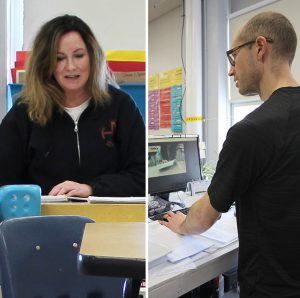 When it comes to filming videos, Claire Rodger admits she’s not used to being in front of the camera.
When it comes to filming videos, Claire Rodger admits she’s not used to being in front of the camera.
“I’m used to being in front of a classroom,” said Rodger, who teaches math, phys-ed and health at Hugh John MacDonald School. “There have been a lot of bloopers but sometimes we leave them in there because we know if we’re laughing, they’re laughing as well.”
Rodger went from posting one video a day to her online classroom to now doing two to three a day. Although she admits it can be time consuming, videos can be a great teaching tool and help keep students engaged in learning.
“Students can take their time, they can review it at their own pleasure which is really nice,” she said, adding she tries to keep her videos short and simple. “They can also re-watch it several times if they have any questions or if they missed something and then they can do their assignment at their own pace.”
Jonathan Burnham, who also teaches math, phys-ed and health at the school, says he tries to make his videos as interesting and visual as possible.
“I’ve put dog ears on my head, just trying to be animated,” he said. “I’ve tried adding text to the videos and stuff like that and exploring different apps to add some fun to it.
“I’ll now be using it daily and finding creative ways to keep the students interested and engaged.”
Warren du Plooy, who teaches Grades 7-9 English at the school, says he’s been focused on keeping his lessons similar to how they would be doing them in the classroom.
“I’m not changing a lot just yet and I’m also trying not to dump a lot of stuff on them all at once,” he said. “I don’t want to make them feel like they’re going to be drowning in work. Many of them aren’t used to doing a ton of work from home.”
His students have also been sending him videos as well.
“With these short little video assignments, I’m trying to show them that they can still interact with each other, connect with each other, even though we’re not supposed to see each other physically.”
When it comes to distance learning, consistency is key, Rodger said.
“Posting something each day is just a reminder that we haven’t forgotten about them and that we’re still around and we want to hear from them.”
Rodger says navigating this pandemic combined with the suspension of classes is “unchartered territory” for a lot of teachers.
“Just like our students, we’re also in a state of wondering what’s going to happen,” she said. “At the end of the day we want everyone to stay safe so if keeping students at home is the best for them, then we’re all for it it’s just sort of figuring out what that looks like in terms of their education.”
Learning can be a Ka-hoot
 The class suspensions have resulted in varying schedules for students. George Pearce, a Grade 7 and 8 math and science teacher at Gordon Bell High School has been having some difficulty getting all ofhis students together for a specific time slot to conduct meetings or lessons.
The class suspensions have resulted in varying schedules for students. George Pearce, a Grade 7 and 8 math and science teacher at Gordon Bell High School has been having some difficulty getting all ofhis students together for a specific time slot to conduct meetings or lessons.
“It’s a tough time for everyone, especially kids. With everything that’s going on it’s hard to focus and many students are just unmotivated to do work,” he said. “It was hard enough to get them engaged in class and now I can’t even get a hold of the kids I really need to.”
He quickly realized that to encourage participation and ensure learning he had to make it fun. Luckily, he knew just what to do. Pearce’s students were already familiar with Kahoot, an online learning platform, since he had used it in the classroom many times.
Kahoot uses multiple-choice questions to boost engagement, while providing real time teacher feedback on complex concepts.
Pearce once again took on the roll of game master, this time from his home computer.
“I live stream my screen and kids watch my stream and answer the questions on their devices by selecting the corresponding button,” said Pearce. “I am able to talk to anyone participating while the questions are up and offer clarification and explanations as needed.”
Recognizing that with social distancing in effect, parents are looking for learning activities for their children, he opened it up, so anyone can join in.
“Students and parents having been having a hoot – a Kahoot to be exact, learning about things like Newton’s Laws and practicing critical thinking and problem solving,” he said.
Pearce also has a Google Hangout with all of his students.
“It is very active. There are hundreds of messages daily,” he said. “I encourage them to split off into their own groups to play online games with each other.”
One of the games frequently played in the Google Hangout is Roblox.
“I had an absolute blast playing Roblox with a group of students this evening,” he said. “It’s a silly game but it allows for great social interactions, which is what I am trying to promote.”
He is also looking into getting Minecraft Education Edition up and running for a more creative gaming approach. The educational version of Minecraft is being used by many educators around the world to teach a range of subjects, from history and chemistry to sustainability and foreign languages.
“I am hoping that from this experience, we as a community of teachers can learn strategies to flip the classroom, leading to using school not as a quiet work time but as a time to collaborate, create and learn important skills. The evening can be left for more independent work, hopefully pulling students away from mass consumption of media,” he said.
Click here to play long! It promises to be a Ka-hooting good time!
Skype keeping us connected
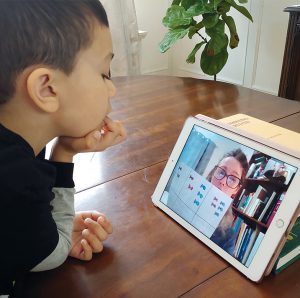 Today was a first for Amélie Carrier. The kindergarten teacher from l’école Précieux-Sang, a K- 8 school in the Division scolaire franco-manitobaine, conducted her first student check –in via Skype.
Today was a first for Amélie Carrier. The kindergarten teacher from l’école Précieux-Sang, a K- 8 school in the Division scolaire franco-manitobaine, conducted her first student check –in via Skype.
Carrier, like many teachers, are turning to online platforms to maintain contact and check on the progress of their students during the two-week class suspension.
“Everything is better when it can be said out loud and interpreted orally,” she said. “It’s also especially important for children to have structure right now, and part of that structure includes seeing their teacher. Having their teacher take time to talk to them, to listen to them and to remind them that we believe in them is critical.”
Carrier plans to check in with each student, 15 in total, on a weekly basis or more frequently if needed. She uses this time to assign new exercises and tasks for the coming week to ensure that her students can continue to develop their skills. She also makes a point of including parents in the conversation.
“It is equally important that parents are supported during this time, so that they feel empowered to help their children in their learning,” she said. “We go over questions the parents might have. If a parent is struggling in a certain subject area, I recommend activities to do with their child. I have access to learning resources and am familiar with the educational needs of each student.”
In addition to Skype, Carrier uses Classroom Dojo, an online tool that connects teachers with students and parents to share resources. The week before the class suspensions, she recorded several short videos focusing on the daily class routine to help parents follow a similar structure and routine at home.
For example, to help with reading, students recite “magic sounds” everyday so Carrier made a video of how this works so parents can continue at home.
She also recorded a student doing the morning message, another very important routine activity at this level.
Today on Skype, she started the morning in the same way she would have in the classroom, with the student reading the morning message.
Bonjour mes amis. Il fait chaud et la neige commence à fondre. Youpi!
Bisous, Madame Amélie
Carrier’s inaugural Skype conversation was not without a few bumps and glitches, from lost connections to pixelated images and disappearing video. She asserts that while technology is so helpful in keeping us connected at this time, it also presents one of the biggest challenges.
“Every parent and child does not have access to all the tools needed to stay connected and each child has different needs,” she said. “Not all software can make long videos for more concrete explanations which is necessary for some parents and children. I am still working out what is the best way to ensure each student is getting what they need to succeed. Nothing can replace the in classroom learning, but we are all trying our best to stay on top of things.”
She said that while students are out of the classroom, parents are key in communicating about their child’s progress.
“It’s important that we make sure that parents know that we are here to help. We’re all in this together,” she said. “When putting together resources and creating my activities for these weeks at home, I imagined that I was not working in the education sector, and I asked myself what would these parents need to be able to able to help their child succeed.”
Carrier will continue sending resources and doing Skype meetings, but is hopeful that she can get back in the classroom sooner rather than later because “learning is much more fun when we’re all together in person.”
Teacher takes science class to YouTube
 Madame Waters and her assistant Félix have been busy over the last week building rockets and launching them, inflating balloons placed over milk bottles, creating chemical reactions and more all thanks to science.
Madame Waters and her assistant Félix have been busy over the last week building rockets and launching them, inflating balloons placed over milk bottles, creating chemical reactions and more all thanks to science.
“When people started pulling their kids out of school, I posted a message on Facebook asking my friends if they would be interested in me starting a YouTube channel with science experiments in French. It was an overwhelming yes,” said Meghan Waters a grade seven and eight teacher at École Varennes. “I am on mat leave so I am able to pick and choose which experiments I want to do. I feel for teachers who have the monumental task of condensing their curriculum. This is a way that I can help.”
Waters is using a book given to her by her mother, a former teacher, which has more than 500 science experiments. After choosing an experiment, Waters translates it into French and then performs the experiment, which is then posted to her YouTube channel.
“I try to pick experiments that use things around the house, or those that can be acquired easily,” she said. “I also incorporate core words when speaking so that kids just learning French will be able to follow along.”
Since the channel has been live, her videos have garnered more than 1,000 views. She is currently working on her seventh video. All videos can be viewed here .
School communities coming together
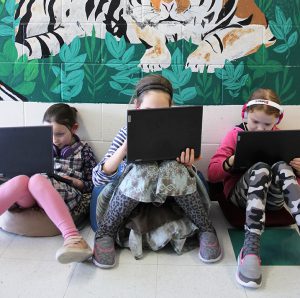 The strength of school communities is on full display now more than ever across Manitoba.
The strength of school communities is on full display now more than ever across Manitoba.
School staff have been rallying together during this difficult and uncertain time to ensure students are as prepared as they can be for distance learning due to COVID-19.
While some schools have carefully crafted take-home kits with plenty of supplies and hard copies of lessons, others have lent out laptops and other technology to ensure all of their students have equal access to online learning. Some schools have also gone the extra mile to ensure students and their families will have access to food during this time.
Michelle Jean-Paul, principal of École Templeton, says their school collected kid-friendly food and cash donations earlier this month for those who rely on meal and snack programs.
“It’s not just teachers, all school staff are jumping in to help put care packages together and go out and deliver them to families,” she said, adding other schools were cooking batches of food to send families home with last week. “It’s great to see our school communities coming together for those in need.”
Teachers are also taking this time to either explore new online teaching resources or utilize what they’ve already been using outside of the classroom. The Manitoba Teachers’ Society has asked teachers to share some of the online tools they are using.
Some of these programs in no particular order include:
- Google Classroom https://classroom.google.com/h
- ClassDojo https://www.classdojo.com/
- Microsoft Office 365 https://www.office.com/
- Microsoft OneNote https://products.office.com/en-ca/onenote/digital-note-taking-app?rtc=1
- Seesaw https://web.seesaw.me/
- Dreambox https://www.dreambox.com/canada (For math)
- Reflex Math https://www.reflexmath.com/
- GoNoodle https://www.gonoodle.com/ (For movement and mindfulness)
- Cosmic Kids Yoga https://www.youtube.com/user/CosmicKidsYoga (For movement and mindfulness)
- Epic Books for Kids https://www.getepic.com/
- Sam Amuse https://www.samamuse.ca/jeux/index.html (French Immersion)
- Idello https://www.idello.org/en (French Immersion)
- Boukili https://boukili.ca/en (French Immersion)
- Boom Cards https://wow.boomlearning.com/
- MiniTFO https://www.tfo.org/en/mini-tfo
- Lalilo https://lalilo.com/?language=en
- Symbaloo https://www.symbaloo.com/home/mix/13eOcLj6h4
- Visual Arts and More https://www.visualartsmore.org/ (Arts)
Applications such as Zoom, Skype, Facebook and Instagram also give teachers the ability to keep in touch with their students via video.
Barb Makowsky, who teaches Grades 5/6 at Centennial School in Selkirk, says she’s encouraging her students to keep some sort of schedule and routine at home.
“We’re trying everything we can to get them engaged in this kind of learning,” she said. “I don’t want them to fall behind.”
Denis Gingras, who teaches both math and science at École Selkirk Junior High, says most of their teachers have their own Weebly based personal websites, which they use to share information and lessons with their students.
He said he keeps his website updated throughout the school year and it’s a great way to communicate with both students and their families. He also made sure to send his students home with paper packages of lessons with links to instructional videos. Although all of these tools are helpful, Gingras says nothing can replace being in real-time in a classroom.
“I never get through a lesson without a student asking a question or two,” said Gingras, who has been teaching for 25 years. “As the years go by, online access is going to increase … but I do have students that have no devices at all or don’t have access to Internet at home … so that limits what they can do.”
Gingras says he’s looking forward to students returning to school.
“We can’t wish this thing away but I’d like to be back to normal as soon as possible,” he said. “When you’re a teacher, you’re a performer in a way and that’s what I’m missing. I just want to get back as soon as possible.”
Jumping jacks on TikTok PhysEd class moves online
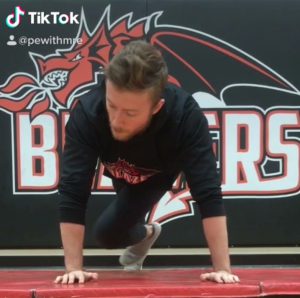 With the suspension of classes due to COVID-19, Teachers have turned to online methods to stay in touch with their students. Brendan Edie, a Grade 7 homeroom and physical education teacher from École Morden Middle School in Morden, MB decided to do just that and PE with Mr.E was born.
With the suspension of classes due to COVID-19, Teachers have turned to online methods to stay in touch with their students. Brendan Edie, a Grade 7 homeroom and physical education teacher from École Morden Middle School in Morden, MB decided to do just that and PE with Mr.E was born.
“Anytime you don’t have kids in the room, whether it be in a classroom or gymnasium, it can be a challenge,” said Edie. “The circumstances that we are currently in have given teachers the opportunity to showcase their creativity.”
Teaching at a middle school has given Edie some valuable insight into the trends, interests and needs of today’s middle school-aged students. He knew that even though students would be at home, for the most part technology and social media would be relatively accessible.
Armed with this knowledge, he launched a 21-day challenge where students can follow along and complete daily physical health and well-being activities online.
“I wanted to create content that I could share with my entire school to help families generate ideas to keep students active,” he said. “It’s a fun way for students to get up and moving while at home.”
Edie acknowledges that his 21-day challenge is similar to what he has seen from many other PE teachers from around the province and points out that, “there are multiple PE teachers at my school who are all working hard at creating various content for their own classes.”
What makes Mr. Edie’s class different is that it is linked to a variety of social media platforms. His 21- day challenge can be accessed via his Twitter page @mredieteaches, and there are multiple ways each week that direct students to his YouTube channel, PE with Mr.E. Once on the YouTube channel, students have the option to workout on their own or complete activities with him – a virtual physical education class.
He has also created additional challenges to supplement the 21-day program on a platform that he is still learning about – TikTok. His TiKTok profile is @PEwithMrE.
“It’s not always a workout, sometimes there are activities like master a TikTok dance, or create an obstacle course at home,” he said. “Though I do value fitness, I think it appeals to a broader range of students when the activity changes.”
There are also live events and streams planned. He has enough curriculum prepared for the current school postponement, with a few activities on deck in the event of extension.
So far, feedback has been positive, with viewers tuning from around the world.
“I’ve received some feedback from other teachers from around the province and the world, and have kids from different places trying the challenge as well,” he said. “It’s great that kids are participating, but as teachers it’s important that we also take the time to practice self-care, and in saying so I encourage everyone to take on the 21 day challenge.”
